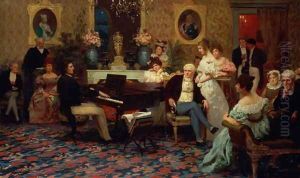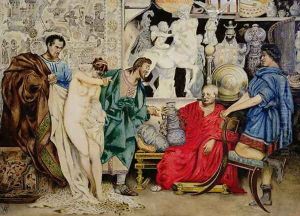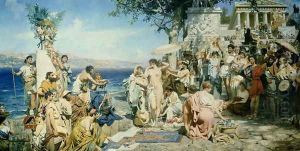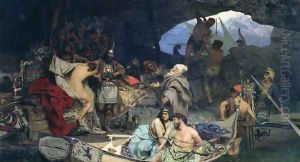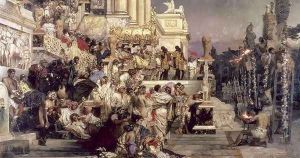Henryk Siemieradzki Paintings
Henryk Siemieradzki was a preeminent Polish painter, born on October 24, 1843, in the small village of Novobelgorod (now in Ukraine), which was part of the Russian Empire at the time. Siemieradzki is best known for his large-scale, academically-inclined historical and mythological paintings, deeply infused with a Romantic spirit and often depicting scenes of grandeur from the ancient world, especially the Roman and early Christian periods. His works are celebrated for their intricate detail, masterful use of light, and the vivid portrayal of the human figure.
Siemieradzki's education in the arts began at the Imperial Academy of Arts in Saint Petersburg, where he honed his skills and developed a penchant for the historical genre. His talent was recognized early on, and he was awarded a scholarship that allowed him to travel to Italy, a country whose rich history and vibrant art scene deeply influenced his style and thematic preferences. Italy became a second home to Siemieradzki; he spent significant periods of his life working and living there, becoming part of the international art scene and earning acclaim across Europe.
Throughout his career, Siemieradzki enjoyed considerable success and was a favored artist among the European elite, receiving numerous commissions from private individuals, the church, and the state. One of his most famous works, 'Christ in the House of Martha and Mary' (1886), is a testament to his ability to blend historical authenticity with dramatic intensity, capturing both the spirit and the minutiae of the epochs he portrayed. His skill in depicting natural light and his refined treatment of the human body are evident across his oeuvre, earning him a place among the leading figures of the European academic art movement of the late 19th century.
Apart from his historical and mythological scenes, Siemieradzki also contributed to the cultural and social life of Poland and Ukraine, engaging in philanthropic activities and supporting the arts. Despite spending much of his career outside Poland, he remained deeply connected to his homeland, contributing to the development of Polish art and participating in the intellectual and cultural discourses of his time.
Henryk Siemieradzki passed away on August 23, 1902, in Strzałków, then part of the Russian Empire, now in Poland. His legacy is preserved in numerous collections across Poland, Ukraine, and Russia, as well as in private collections worldwide. Siemieradzki's works continue to be admired for their beauty, technical mastery, and the window they offer into the historical and mythological narratives that shaped European culture.
